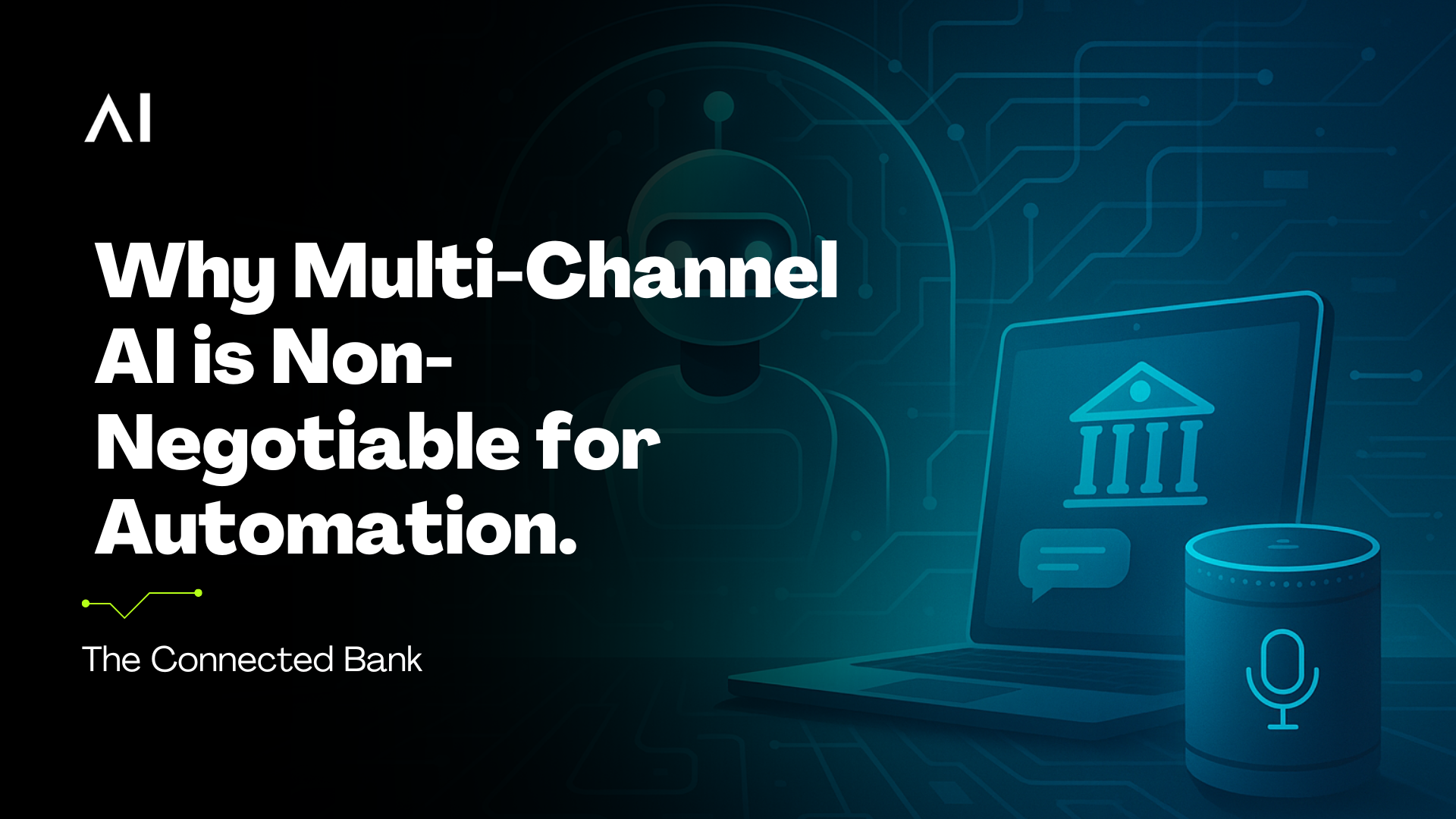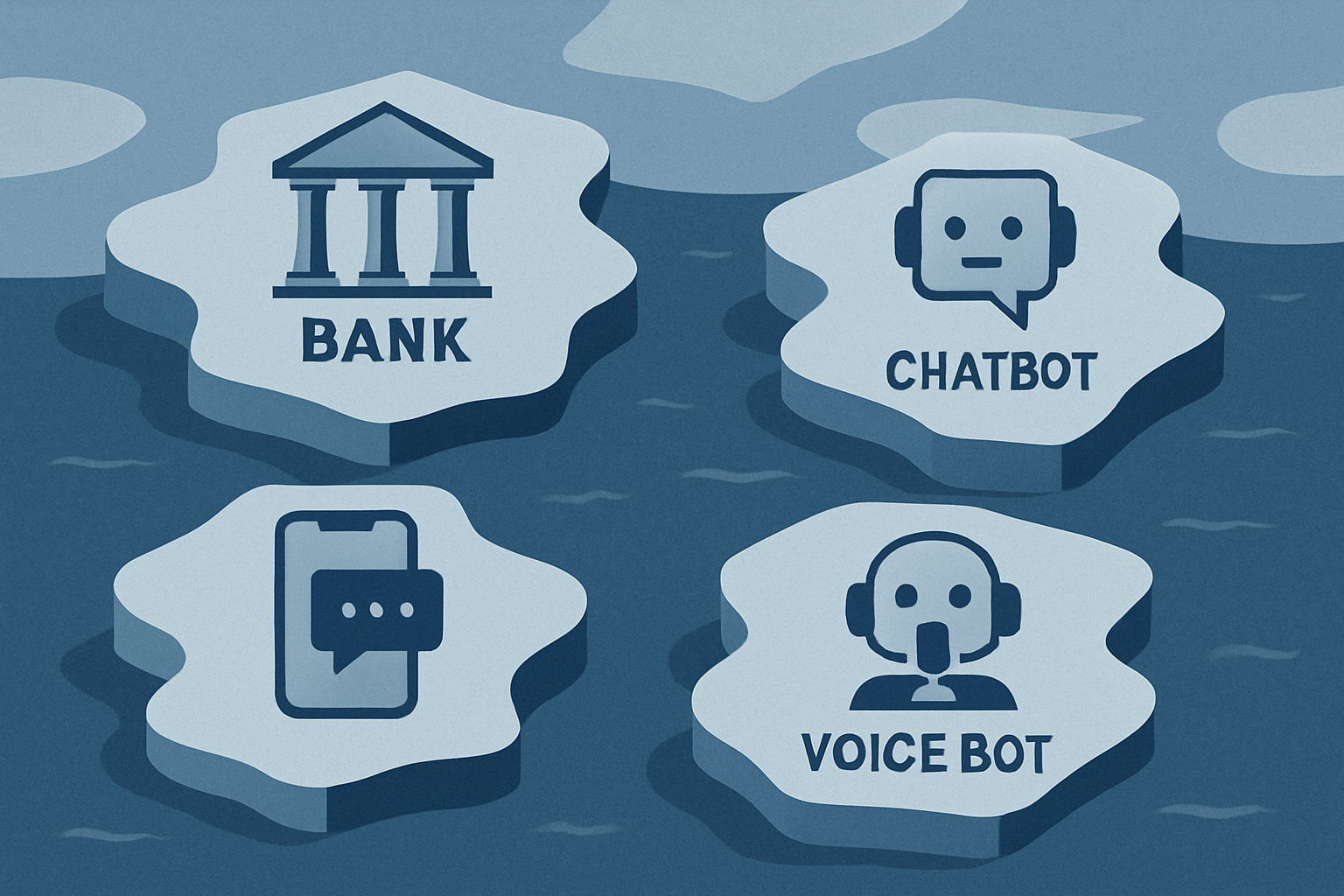Join our WhatsApp Community
AI-powered WhatsApp community for insights, support, and real-time collaboration.
Multi-channel AI unifies chatbots, voice bots, and virtual assistants for seamless banking, breaking silos to deliver connected, efficient, and future-ready experiences.

| Why is AI important in the banking sector? | The shift from traditional in-person banking to online and mobile platforms has increased customer demand for instant, personalized service. |
| AI Virtual Assistants in Focus: | Banks are investing in AI-driven virtual assistants to create hyper-personalised, real-time solutions that improve customer experiences. |
| What is the top challenge of using AI in banking? | Inefficiencies like higher Average Handling Time (AHT), lack of real-time data, and limited personalization hinder existing customer service strategies. |
| Limits of Traditional Automation: | Automated systems need more nuanced queries, making them less effective for high-value customers with complex needs. |
| What are the benefits of AI chatbots in Banking? | AI virtual assistants enhance efficiency, reduce operational costs, and empower CSRs by handling repetitive tasks and offering personalized interactions. |
| Future Outlook of AI-enabled Virtual Assistants: | AI will transform the role of CSRs into more strategic, relationship-focused positions while continuing to elevate the customer experience in banking. |
In the rapidly evolving landscape of artificial intelligence, terms like 'AI chatbot,' 'voice bot,' and 'virtual assistant' are commonplace. However, the true power of AI in enterprise settings, particularly in sectors like banking, emerges not from isolated deployments of these tools, but from their seamless integration into a 'multi-channel AI' ecosystem. So, what exactly does multi-channel AI mean?
At its core, multi-channel AI refers to an intelligent system where various AI-powered tools and touchpoints work together in a coordinated and unified manner across different communication channels. Instead of operating as independent silos, these AI components share information, context, and learning, providing a consistent and continuous experience for users, whether they are interacting via a website chatbot, a mobile app, a voice assistant, or even a human agent supported by AI.
Think of it as a central nervous system for customer interactions and operational processes. Each AI 'organ' (like a chatbot or voice bot) contributes to and draws from a shared pool of knowledge and understanding. This allows for:
In essence, multi-channel AI transforms a collection of disparate AI tools into a cohesive, intelligent network that learns, adapts, and delivers superior experiences by leveraging the collective intelligence of all its components. It's about moving beyond individual AI solutions to a truly integrated, agentic AI framework that understands and responds to the entire customer journey.

In today's hyper-connected world, expectations for service are sky-high. We expect instant answers, personalized experiences, and the freedom to switch channels seamlessly — whether we're ordering groceries or, crucially, managing our finances. For banks, meeting these evolving demands isn't just a value-add; it's essential for survival. The promise of artificial intelligence (AI) — particularly agentic AI frameworks — in banking automation is immense, offering the potential to revolutionize everything from customer engagement to back-office operations.
Yet many banks fall into a common trap: adopting AI tools in silos. They may have a slick banking chatbot, a separate AI voice bot for customer support, and another internal tool for automation. While each may be effective individually, their lack of integration creates a fragmented experience for both customers and employees. This isn't true automation — it's a patchwork of disconnected solutions.
Imagine a customer begins a query with a banking chatbot on the website and then calls support for more help. The AI voice agent on the phone doesn’t know what the chatbot discussed, so the customer must repeat everything — a frustrating and all-too-common reality of fragmented AI systems.
When chatbots in banking, voice agents, and human reps don’t share data, customers are forced to re-explain problems. This leads to dissatisfaction and makes the bank appear disorganized.
Disconnected tools create separate data pools. AI agents in finance can't learn holistically from user interactions across channels, missing out on behavior insights that could improve personalization and service.
An AI that only processes credit card applications through a chatbot but doesn’t connect to the AI for document verification or customer onboarding, leaves the workflow incomplete.
Maintaining multiple AI solutions, each with its own interface, training, and infrastructure, raises costs and delays new feature rollouts.
Fragmented AI is like having powerful engines without a transmission: a lot of potential power, but no coordinated movement.
Pitfalls of Fragmented AI: Why Single Channels Don't Work.

If fragmented AI is a set of disconnected islands, multi-channel AI is a connected continent. Every chatbot, voice bot, virtual assistant, and backend AI system works as a unified agentic framework, where intelligence and data flow continuously.
Imagine a customer beginning a home loan application on a mobile app. They switch to a website chatbot with a query and later get support from an AI voice agent. All systems are synchronized — every agent knows exactly where the customer left off. This is the hallmark of a seamless experience driven by agentic AI orchestration.
All touchpoints contribute to a centralized AI knowledge management system, allowing AI to build a rich, 360-degree customer profile. From analyzing voice interactions to identifying chatbot drop-offs, the system continuously learns and improves service delivery.
By deploying agentic AI tools across channels, banks can streamline resource allocation, reduce manual errors, and provide real-time, contextual responses. This intelligent integration not only lowers operational costs but also accelerates responsiveness to market shifts.
All customer and operational data feeds into a single platform, enabling AI to deliver consistent, informed responses across interfaces.
Customer journeys are guided through transitions between bots and human agents with zero context loss.
AI systems improve through ongoing exposure to multi-channel data, enabling faster evolution and personalization.
While AI handles volume, human agents step in for complex, emotional, or sensitive cases — equipped with full context and insights.
Beyond just customer service, multi-channel AI plays a pivotal role in content contribution and management within an organization, especially in a data-rich environment like banking. This involves leveraging AI to generate, curate, and distribute relevant content across various channels, ensuring consistency and personalization.
Multi-channel AI systems can automate the creation of various types of content. For instance, they can generate personalized financial reports, summarize complex policy documents into easily digestible FAQs, or even draft initial responses for common customer inquiries. By analyzing vast amounts of data, AI can identify trends and common questions, proactively generating content that addresses customer needs before they even ask.
With a unified data layer, multi-channel AI ensures that the right content reaches the right customer at the right time, through their preferred channel. This means a customer might receive a personalized loan offer via their mobile banking app, a relevant article about investment strategies through an email, or a quick answer to a specific question from a chatbot – all seamlessly integrated and consistent. This dynamic delivery enhances the customer experience by providing timely and relevant information, reducing information overload.
Multi-channel AI continuously learns from customer interactions across all touchpoints. This learning can be fed back into the central knowledge management system, enriching the content available to both AI agents and human employees. For example, if a new type of query frequently arises in chatbot conversations, the AI can flag this, suggesting the creation of new FAQ entries or updates to existing knowledge base articles. This iterative process ensures that the content is always up-to-date and comprehensive.
One of the most significant contributions of multi-channel AI to content is the ability to personalize communications at scale. Instead of generic messages, AI can tailor content based on individual customer profiles, transaction history, and expressed preferences. This level of personalization fosters deeper engagement and builds stronger customer relationships, as customers feel understood and valued. This is particularly relevant in banking, where personalized advice and product recommendations can significantly impact customer loyalty and financial well-being.
In essence, multi-channel AI transforms content from a static resource into a dynamic, intelligent asset that actively contributes to customer satisfaction and operational efficiency. It moves beyond simply providing information to actively engaging customers with relevant, timely, and personalized content, fostering a more informed and empowered customer base.

The future of banking lies in embracing truly integrated, agentic AI ecosystems. Disconnected tools can no longer support the needs of digital-first customers. With the right blend of multi-channel AI, unified data, and intelligent orchestration, banks can deliver seamless experiences, increase efficiency, and stay competitive in a fast-evolving market.
It's time to go beyond chatbots. It's time to deliver connected intelligence.
Fluid AI is an AI company based in Mumbai. We help organizations kickstart their AI journey. If you’re seeking a solution for your organization to enhance customer support, boost employee productivity and make the most of your organization’s data, look no further.
Take the first step on this exciting journey by booking a Free Discovery Call with us today and let us help you make your organization future-ready and unlock the full potential of AI for your organization.

AI-powered WhatsApp community for insights, support, and real-time collaboration.
.webp)
.webp)

Join leading businesses using the
Agentic AI Platform to drive efficiency, innovation, and growth.
AI-powered WhatsApp community for insights, support, and real-time collaboration.